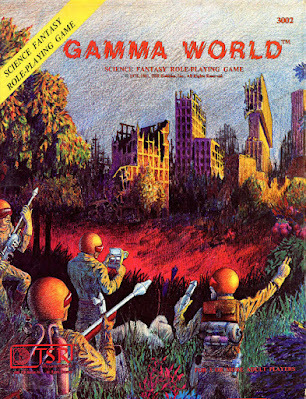The Setting of Gamma World (Part I)
 A little while ago, I wrote a short post about the inspirations of Gamma World. My original purpose was to draw attention to the handful of explicit (primarily literary) inspirations mentioned in the 1978 game's foreword. In doing so, though, I found myself thinking more and more about the seeming disjunction between the way the game presents itself and the way it was viewed by players and referees at the time (and in the years since).
A little while ago, I wrote a short post about the inspirations of Gamma World. My original purpose was to draw attention to the handful of explicit (primarily literary) inspirations mentioned in the 1978 game's foreword. In doing so, though, I found myself thinking more and more about the seeming disjunction between the way the game presents itself and the way it was viewed by players and referees at the time (and in the years since). The first thing that immediately stands out is that the apocalypse of Gamma World occurs in the early 24th century (2322, at least according to the first edition) rather than in the present day or near future. This is the justification for the inclusion of laser weapons and robots and hover cars, for example. I suspect it's also a consequence of the fact that Gamma World's precursor, Metamorphosis Alpha, being set aboard a generation ship, included lots of high technology as well. At the same time, I've come to think that, to the extent it actually has one, James M. Ward's "vision" for Gamma World is closer to Jack Vance's The Dying Earth than The Road Warrior (and not just because the latter postdates the former).
Despite this, Gamma World doesn't always do a very good job of getting point across. Indeed, if you take a look at all the products released for the first edition of the game – the boxed set, the Referee's Screen, Legion of Gold, and Famine in Far-Go – you'll quickly detect a certain schizophrenia about its setting. On the one hand, there are plenty of examples of the science fictional high technology that one would expect for a world several centuries hence. On the other, there are plenty of nods to familiar, 20th century things that, frankly, make little or no sense within that context. This inability to stay consistent about the setting of the game, I think, contributed to many popular misapprehensions about the game.
For the most part, the original Gamma World rulebook knows what it's about and sticks to the idea that the game takes place in the aftermath of a civilization-shattering disaster in the 24th century. There are thus references to robotic farms and spaceports, in addition to the usual wondrous devices of the Ancients, like blasters, powered armor, and energy cells. There's also much talk of robots, cyborgs, androids, and what we would today call artificial intelligences. The picture the rulebook paints is largely one of a futuristic world fallen to barbarism.
I say "largely," because there's a section, at the very end of the book that, in my opinion, weakens the game's commitment to this futuristic world. That section is its "treasure list," consisting of 100 random items the player characters might find among the ruins. These "treasures" are distinct from the weapons, armor, and other devices in that they are usually of much less obvious utility. They're "artifacts of the Ancients" only in the sense that they represent goods and items from the World Before. In most cases, they're little more than curiosities of the past.
In principle, that's a terrific thing. Every human civilization has left behind plenty of artifacts to be found by later ages. Examining these artifacts are part of what enables us to learn about those dead civilizations and so it should be in a post-apocalyptic setting. However, many – in fact, the majority – of the treasures included in this list are items that make little or no sense in the context of a technologically advanced, futuristic society. Worse still, quite a few of them come across as jokey. So, you get things like a pencil sharpener, a slot machine, a cash register, and a cuckoo clock, alongside pewter TSR belt buckle, hand-painted miniature lead figurines, and a rollerball trophy.
What's most striking about these treasures is that, with a handful of exceptions, they're items that only make sense in a 20th century context rather than being products of a more technologically advanced society. Certainly, one can come up with all sorts of explanations/justifications for why they can still be found in the setting, but I can't help feel this was a missed opportunity to introduce some original – and weird – products of the World Before. This feeling isn't lessened by all the little silly and self-referential items, like the belt buckle and miniatures.
These criticisms aside, the Gamma World rulebook otherwise does a good job of sticking to its script. The setting it describes is that of a fallen high-tech civilization and its artifacts reflect this. The end result is a world that is almost as alien to its players as it is to the primitive player characters living in its ruins. Gamma World calls itself a "science fantasy roleplaying game" not so much, I think, because the technology of the Ancients is scientifically implausible, but rather because the Earth its setting is now utterly fantastical, thanks to the effects of the apocalypse that engulfed it.
James Maliszewski's Blog
- James Maliszewski's profile
- 3 followers



